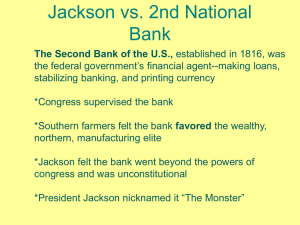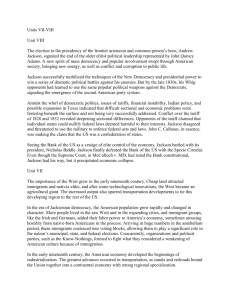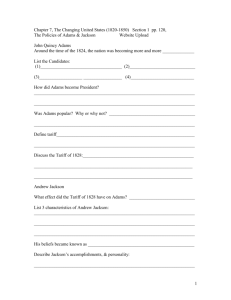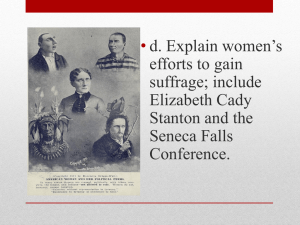The Jacksonian Era
advertisement
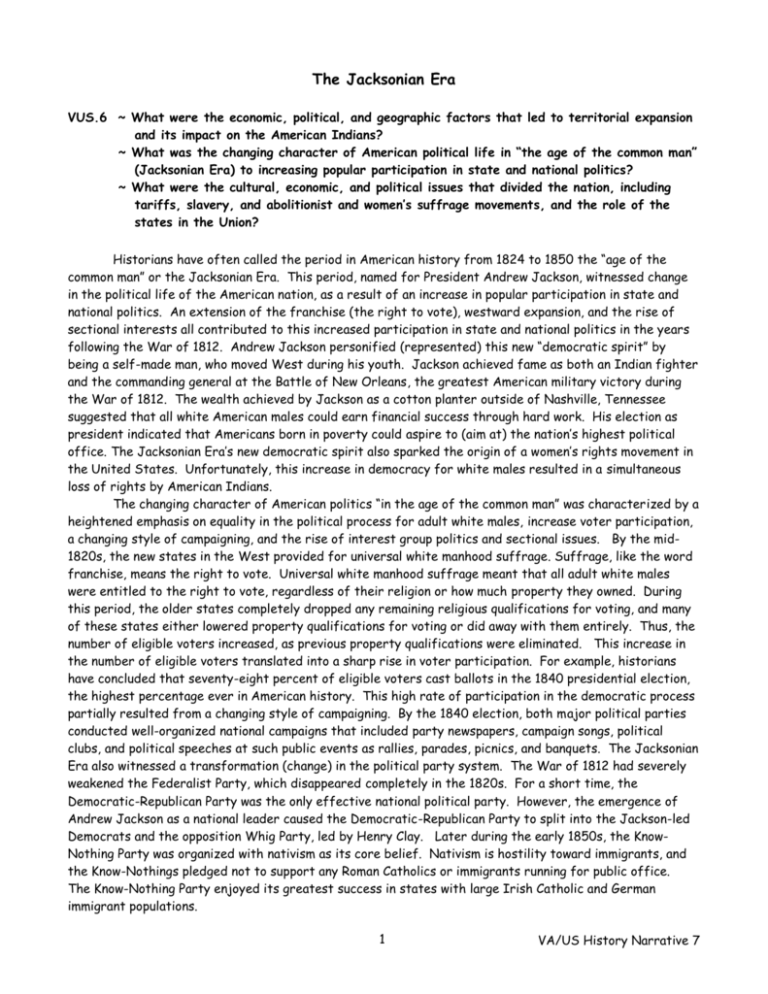
The Jacksonian Era VUS.6 ~ What were the economic, political, and geographic factors that led to territorial expansion and its impact on the American Indians? ~ What was the changing character of American political life in “the age of the common man” (Jacksonian Era) to increasing popular participation in state and national politics? ~ What were the cultural, economic, and political issues that divided the nation, including tariffs, slavery, and abolitionist and women’s suffrage movements, and the role of the states in the Union? Historians have often called the period in American history from 1824 to 1850 the “age of the common man” or the Jacksonian Era. This period, named for President Andrew Jackson, witnessed change in the political life of the American nation, as a result of an increase in popular participation in state and national politics. An extension of the franchise (the right to vote), westward expansion, and the rise of sectional interests all contributed to this increased participation in state and national politics in the years following the War of 1812. Andrew Jackson personified (represented) this new “democratic spirit” by being a self-made man, who moved West during his youth. Jackson achieved fame as both an Indian fighter and the commanding general at the Battle of New Orleans, the greatest American military victory during the War of 1812. The wealth achieved by Jackson as a cotton planter outside of Nashville, Tennessee suggested that all white American males could earn financial success through hard work. His election as president indicated that Americans born in poverty could aspire to (aim at) the nation’s highest political office. The Jacksonian Era’s new democratic spirit also sparked the origin of a women’s rights movement in the United States. Unfortunately, this increase in democracy for white males resulted in a simultaneous loss of rights by American Indians. The changing character of American politics “in the age of the common man” was characterized by a heightened emphasis on equality in the political process for adult white males, increase voter participation, a changing style of campaigning, and the rise of interest group politics and sectional issues. By the mid1820s, the new states in the West provided for universal white manhood suffrage. Suffrage, like the word franchise, means the right to vote. Universal white manhood suffrage meant that all adult white males were entitled to the right to vote, regardless of their religion or how much property they owned. During this period, the older states completely dropped any remaining religious qualifications for voting, and many of these states either lowered property qualifications for voting or did away with them entirely. Thus, the number of eligible voters increased, as previous property qualifications were eliminated. This increase in the number of eligible voters translated into a sharp rise in voter participation. For example, historians have concluded that seventy-eight percent of eligible voters cast ballots in the 1840 presidential election, the highest percentage ever in American history. This high rate of participation in the democratic process partially resulted from a changing style of campaigning. By the 1840 election, both major political parties conducted well-organized national campaigns that included party newspapers, campaign songs, political clubs, and political speeches at such public events as rallies, parades, picnics, and banquets. The Jacksonian Era also witnessed a transformation (change) in the political party system. The War of 1812 had severely weakened the Federalist Party, which disappeared completely in the 1820s. For a short time, the Democratic-Republican Party was the only effective national political party. However, the emergence of Andrew Jackson as a national leader caused the Democratic-Republican Party to split into the Jackson-led Democrats and the opposition Whig Party, led by Henry Clay. Later during the early 1850s, the KnowNothing Party was organized with nativism as its core belief. Nativism is hostility toward immigrants, and the Know-Nothings pledged not to support any Roman Catholics or immigrants running for public office. The Know-Nothing Party enjoyed its greatest success in states with large Irish Catholic and German immigrant populations. 1 VA/US History Narrative 7 When President Jackson took office as president in 1829, he employed the spoils system by rewarding his supporters with government jobs. One may define the spoils system as the practice of using public offices to benefit members of the victorious political party. In short, the spoils system is the practice of an elected official giving government jobs to his political supporters. Although Jackson’s opponents criticized the spoils system for failing to put the most qualified people in government jobs, Jackson considered this practice a democratic reform. He called it rotation-in-office and believed that in a democracy every white male citizen should participate in government service at some point during his lifetime. Andrew Jackson also championed democracy by challenging economic elites in his opposition to the Second Bank of the United States (BUS). Jackson distrusted the Bank of the United States as an undemocratic tool of the Eastern elite (the wealthy, privileged business class). Therefore, President Jackson vetoed a bill to recharter the BUS in 1832. A presidential veto is the power granted to the President by the Constitution to prevent a bill, passed by Congress, from becoming law. It is part of the Constitution’s checks and balances system. This veto of the bank recharter bill was the first presidential veto not based solely on constitutional grounds. In his veto message to Congress Jackson stated that a President had the right to veto any legislation for any reason whatsoever. Andrew Jackson’s bank veto made the presidential veto part of the legislative process, because thereafter Congress was forced to consider a possible presidential veto whenever it passed a bill. Jackson’s action on the bank recharter bill set precedent for later presidents to veto any legislation they opposed. His bank veto became the major issue in his 1832 re-election campaign. When Jackson won an overwhelming victory in this election, he took it as a sign that the American public approved of his war on the Second Bank of the United States. In his second term, President Jackson set out to destroy the power of the BUS and succeeded in doing so before he left office. The rise of sectional interests also contributed to increased popular participation in state and national politics during the Jacksonian Era. Sectional interests meant an American was less concerned about the national welfare than he was about the well-being of his region: North, South, or West. The primary sectional incident of Andrew Jackson’s presidency was the Nullification Crisis. Near the end of Jackson’s first term, Congress passed the Tariff of 1832, which set high taxes on imported goods. (A tariff is a tax on imports.) The leaders of South Carolina argued that since states were sovereign or self-governing, they possessed the power to nullify or void federal laws. South Carolinians also argued that since South Carolina had voluntarily joined the Union, it had the right to secede or voluntarily withdraw from the United States. South Carolina nullified the Tariff of 1832 and threatened to secede from the Union. These actions endangered the future existence of the United States, since a Union that allowed state governments to invalidate (undo) acts of the national legislature (Congress) could be dissolved by states seceding from the Union in defense of slavery. President Jackson clearly recognized the danger posed to the federal government by South Carolina’s nullification of the new tariff law. As commander in chief of the armed forces, President Andrew Jackson threatened to send federal troops to South Carolina to collect the tariff revenues. Congress then passed a compromise tariff bill in 1833, which allowed both sides to back down from the approaching confrontation (fight). Jackson and South Carolina had differed sharply over the nature of the Union. President Jackson had stood firmly for federal authority over the states. South Carolinians had stood firmly in support of states’ rights and claimed victory as a result of the compromise bill’s tariff reduction. Although the Nullification Crisis passed, it suggested that the issues of states’ rights and slavery would continue to divide the American nation in the years ahead. Ironically, the reforms of Jacksonian democracy did not extend to the American Indians. As westward migration continued throughout the Jacksonian period, the American Indians were repeatedly defeated in violent conflicts with settlers and soldiers and forcibly removed from their ancestral homelands to make way for white Americans. Conflicts between American settlers and Indian nations in the Southeast and the old Northwest (especially Illinois and Wisconsin) resulted in the relocation of many Indians to reservations. In 1830, at President Jackson’s request, Congress passed the Indian Removal Act, 2 VA/US History Narrative 7 which required the forced relocation (removal) of the Southeastern Indians to a new Indian Territory in what is now Oklahoma. The forced journey of Cherokee Indians from their homes in Georgia to these lands in the west in 1838 and 1839 became known as the Trail of Tears. On this march, nearly one-fourth of the 15,000 Cherokees died of hardship, sickness, and starvation. In addition to the Cherokees, other Southeastern tribes forced to move to Oklahoma included the Creeks, Chickasaws, and later the Seminoles. Finally, Jacksonian democracy sparked a women’s rights movement. This reform movement worked to give equal rights to American women, especially the right to vote. It formally began in 1848 at a meeting at Seneca Falls, New York. This gathering of approximately one hundred women and men voted to support a Declaration of Women’s Rights. Among the rights called for by the Seneca Falls Declaration was women’s suffrage or the right to vote. Two of the most important leaders of this women’s rights movement were Elizabeth Cady Stanton and Susan B. Anthony. Both of these women continued their activities on behalf of equal rights for American women after the Civil War. 3 VA/US History Narrative 7


